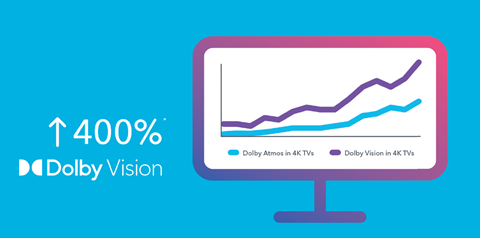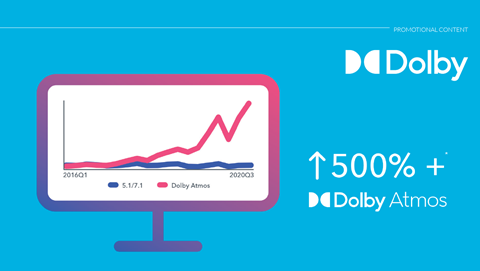 Sponsored content
Sponsored content
With most of the major manufacturers on board and 50-inch TV sets featuring Dolby Atmos and Dolby Vision now available for less than £300, a high-end viewing experience is within everyone’s reach

Industry veterans at the top of audio and video production might think they have heard and seen it all, but now Dolby Vision and Dolby Atmos redefine the pinnacle of perfect playback.
Dolby Vision has transformed the viewing experience, delivering a picture that is both more vivid and more refi ned than was previously possible. The format allows for active high dynamic range, meaning a Dolby Vision-compatible device – whether TV, tablet, phone or computer – adjusts the picture as it is playing. The result is that bright and dark areas of the picture can be optimised so neither overwhelms the other. Details formerly lost in underlit scenes are visible. The nuances of sunlight on a rippling lake are not washed out.
Dolby Atmos, similarly, has transformed the listening experience. The format is already supported by more than 500 million consumer electronic devices that can play
Dolby Atmos content. How did half a billion compatible devices come to market and start shaping every aspect of audio? That is a great story of building a brand-new ecosystem of content and devices in a way that wisely avoided the chicken-and-egg problem that hamstrings many new formats.
Dolby makes high-quality media experiences available for everyone
As the Dolby ecosystem has expanded, content creators have embraced it. Netflix now makes all of its homegrown productions in Dolby Vision, and more and more of its productions are also in Dolby Atmos. Through Netflix, Disney+, Apple TV and other streaming services and broadcasters, some 300 million subscribers worldwide now have access to content in Dolby Vision, Dolby Atmos or – best of all – both.
Dolby Vision and Dolby Atmos together provide an immersive experience across a range of content. Playback is optimised using the metadata (settings encoded in the fi le) to ensure the consumer gets a consistent, high-quality experience across devices. Creators can ensure their content is as good as it can be and consumers can be confi dent they are experiencing their movie, video or music exactly the way the creator intended.
Most major TV makers – LG, Vestel, Philips, Sony, Sharp, Panasonic, Vizio and many others – have adopted Dolby Vision. It’s expanded from being a premium-tier-only feature and is now available at almost every level. For example, TV sets in the 50-inch range that feature both Dolby Vision and Dolby Atmos can be found for under £300 in the UK and for less than €300 across Europe. Dolby Vision can also be found in all price categories across mobile phones, laptops and tablets.

We’ve democratised the high-end experience, making this rich ecosystem widely available at many price points. Take of 5.1 or 7.1 surround sound. Those systems sound great but can be too cumbersome and expensive for the home.
With virtualised spatial sound and the latest digital signal processing to optimise for every device, users can get an immersive experience on soundbars and mobile devices, and more elaborate set-ups. Creators get a bigger audience and users can participate at virtually all price points.
Whatever customers can pay, they’ll get a better experience with Dolby Vision and Dolby Atmos. A global ecosystem of Dolby Vision and Dolby Atmos devices has quietly evolved, and it’s already starting to open a lot of eyes and make a lot more noise. And that looks and sounds great to us.

























